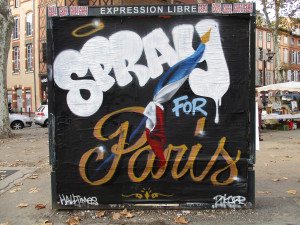Paris attacks: ‘The pen is mightier than the sword’
Today I’d like to write about Paris, art and terrorism. Art has always been an integral part of any culture; it’s an inherently valuable commodity, the mode of expression of a collective people, a source of rich history.
This means it has always been a target in wartime, as well as a way of defending and fighting back. This dynamic has never been more apparent to me than this past week in Paris, when the city I live in came under attack from Islamic State terrorists.
It cannot be overlooked that of the three points in the city that was targeted, the most deadly location, in which over 80 people were executed, was the Bataclan Arts Centre.
The terrorist attack was certainly an expression of disgust with the artistic culture of Paris
During the hours of Friday night, as the news came in and sirens screamed around my home, I noticed an image by Jean Jullien appear on Facebook. Over the course of the following day, the painted image, the peace symbol with the Eiffel Tower incorporated into it, blew up across the Internet, and made the cover of many artist magazines.
The terrorist attack was certainly an expression of disgust with the artistic culture of Paris. They shot into restaurants where people smoked and laughed and ate together, they bombed a football stadium that people cheered in, and they executed a crowd of people dancing to rock and roll.
They assaulted the artistic qualities that the French express in their food and their music. Now, Francois Hollande, the French President, has claimed in a recent UNESCO conference he is creating plans to grant “asylum” to art and valuable archeological sites that might be targeted by the IS.
It’s not the first time that art has been targeted by invaders. You could point to almost anywhere on the globe to see it. Italy has had its art looted by many countries since Napoleon, with US museums including the MET returning art even now. Look at the looting of Poland by Russian troops following the second Partition of Poland and Kościuszko Uprising in 1794. The robbery of the tombs of Latin and South America by the Spanish Empire are infamous.
Let us not forget the looting of art by the British Empire in its colonizing efforts in Asia, India and Africa. Think of the Nazi plunder between 1933-1945 which saw the organized looting of European countries and thousands of pieces of art. Since 2003 and the U.S entrance into Iraq, over 13,000 artifacts have been stolen.
Among many other attacks, IS militants have blown up the Arch of Triumph, a major monument in the 2,000-year-old Roman city of Palmyra. In August, the Sunni Muslim militants blew up the temple of Baal Shamin. The French have credence to be anxious over the preservation of their artistic heritage.
Following Friday 13 November, I am reminded of the terrorist attack on Paris earlier this year in January, when gunmen stormed the offices of the satirical magazine Charlie Hebdo. The outpouring of sketches and cartoons that mocked the terrorists as a result, when fellow graphic artists turned their pens to the page in defiance, was a living example of that old proverb that the pen is mightier than the sword.
When mourners came to the République site, they brought art. When I pass it, I see mounds of artistic offerings; drawings by children, paintings and sketchings by artists, hand written poems tied to candles, books laid by family members of the deceased. People draw in chalk on the square, only for it to be washed away with rain. It is a place of grief and a place of artistic expression of that grief.
Artistic movements such as #PrayForParis have seen buildings all over the world transformed with graffiti as artists express their solidarity.
You see, the Parisians and those who support Paris from around the world have shown that their artistic liberty of expression is a non-negotiable and uniting force against violence.
Feeding myself on the art of others helped me through the aftermath of the attacks. I found strength in the poems, in the man who played ‘Imagine’ to the crowds at République, in the words written about the event and the visual art that surrounded it. It is, quite simply, the most beautiful art I have ever seen.




Comments